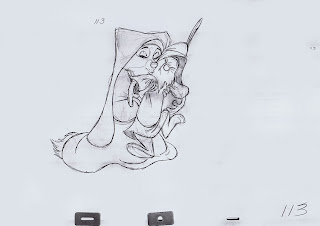Milt Kahl often pushed the contact between two characters in order to achieve physical believability, but also comedy.
In these animation drawings Maid Marion acts out a romantic encounter with her playmate hero, Skippy. From the moment the characters' faces make contact you see how their facial features react, especially their cheeks, because they are soft.
For the final kiss Milt even squashed Maid Marion's muzzle, which is surprising because it is a boney part of a fox's head. But this makes for a more intense contact, and it looks funny.
As usual when Milt stages something like this, lines and shapes flow toward the area of interest, like the feather on Skippy's hat, Marion's eye line etc.
The last pose is pretty exaggerated, but still appealing.
Story artist Burny Mattinson used Milt's pose for a Robin Hood book illustration.
Burny did a number of beautiful Disney story books in the 1960ies and -70ies.








So inspiring to see!!! Thanx!!
ReplyDeleteInteresting to see the charts on the right!
ReplyDelete:)
ReplyDeleteOne of my favorite scenes!
ReplyDeleteThank you always for sharing and I love your insights.
Very helpful and inspiring!
Did Milt also animate the other two sister rabbits?
I love their child like moves and expressions :)
Cheers,
Junko
Frank Thomas did a few scenes with the bunny sisters.
DeleteOne of these days I need to get Burny to sign my copy of his Robin Hood book!
ReplyDeleteThe plasticity of the characters is used beautifully in this scene -- right down to the drag on Skippy's hands and feet as he tries to escape!
ReplyDeleteOne of my favorite scenes as well! I would think that the squash of Marion's muzzle is merely the bunching of skin on Marion's snout as the bone is pressed into Skippy's cheek. Not that there's anything wrong with squashing the whole thing ;)
ReplyDeleteWhat I find amazing is that he's able to direct your eye on every frame of this action.. It's one thing to draw it as a still frame.. but it's even more amazing when your moving through it in time with weight and believability.. Even the secondary action and overlap is controlled so precisely that it directs your eye ON EVERY FRAME!... It's the movement, the graphic siloutte, the lines, the personality, the weight.. almost like ballet
ReplyDeleteTake for example the edge of that fabric around her face.. and look at the relationship to the feather on the rabbit's head.. There is a strong poetic/graphic/performance between those two lines as you flip through it frame by frame.. and yet it doesn't feel at all contrived but natural..
Hey Andreas, do you think you could do a post about staging through time(not just as a single pose)? It amazes me that it is staged so beautifully FRAME by FRAME!!
That same face-squish occurs when my little sister hug-attacks me, haha ';) Love the motion in this, especially Skippy's arm and leg flails.
ReplyDeletethat is awesome. :)
ReplyDeleteI can really feel her nose scrunching up on the last drawing. I don't fully understand timing charts yet. There are so many on one page.
ReplyDeleteThere's such a beautiful innocence of childhood represented here. It's a shame that so few movies for children today are good enough to capture that.
ReplyDeleteLove this sequence
ReplyDeleteThis kind of character interaction was easier to make when all characters in the scene was drawn by the same animator. In 'Illusion of Life', Frank and Ollie consider this an advantage brought in by nine old man, to animate all characters in the scene instead of having an animator assigned to a specific characters.
ReplyDeleteDuring Disney's reinassance, however, the characters were again assigned by specific animators, like with scene of Jasmine talking to Jaffar or Alladin and Jasmine animated in two separate studios. Was there a specific reason for returning back to animating the characters separately? Was it because the characters were supposed to be so much contrasting?
My generation of animators had a range of different drawing styles. So to keep a character on model it was decided that one supervising animator be responsible for one character.
DeleteBy the end of the production you could say, I did this character,
not so much I did this whole sequence.
We were pretty much ok with that.
Thanks for the reply :) This makes a lot of sense to me. Maybe this closer relationship between supervising animators and their characters is what made Disney's Reinessance films so great, because the creation of the character become a form of personal expression.
DeleteI love all the follow through action with this and how the skin looks like it moves over the bones. Great squash and stretch
ReplyDeleteI'd love to know what medium or mediums Burny Mattinson used to make his wonderful illustrations.
ReplyDelete